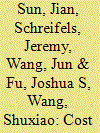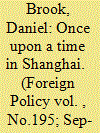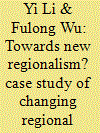| Srl | Item |
| 1 |
ID:
155331


|
|
|
|
|
| Summary/Abstract |
This article examines the economic influence of Chinese living abroad (huaqiao) on the development of the 21st Century Maritime Silk Road on PRC territory. The author analyzes the territorial structure of investments and the branch structure of the huaqiao companies in the region of the Bohai Bay ring, the Yangtze River Delta, southern maritime regions and the southern shore of the PRC western regions through which the Maritime Silk Road will pass.
|
|
|
|
|
|
|
|
|
|
|
|
|
|
|
|
| 2 |
ID:
132682


|
|
|
|
|
| Publication |
2014.
|
| Summary/Abstract |
Coal-fired power plants in China have emitted multiple pollutants including sulfur dioxide, nitrogen oxides and fine particulates, contributing to serious environmental impairments and human health issues. To meet ambient air quality standards, the installation of effective pollution control technologies are required and consequently, the cost of installing or retrofitting control technologies is an important economic and political concern. A multi-pollutant control cost model, CoST CE, is developed to calculate the cost of multi-pollutant control strategies in the Yangtze River Delta region (YRD) of China, adopting an LP algorithm to optimize the sorting of control technology costs and quickly obtain a solution. The output shows that total costs will increase along with emission abatement. Meanwhile, the slope becomes steeper as greater emission reductions are pursued, due to the need to install highly effective, but expensive, technologies like SCR and FF. Moreover, it is evident that the cost curve shapes, maximum abatement potential and total cost for the three provinces in the YRD region are quite different due to differences in power plant type and technologies, current emission levels and existing pollution controls. The results from this study can aid policy makers to develop cost-effective control strategies for the power sector.
|
|
|
|
|
|
|
|
|
|
|
|
|
|
|
|
| 3 |
ID:
114591


|
|
|
|
|
| Publication |
2012.
|
| Summary/Abstract |
In recent years, the economic development of China's Yangtze River Delta, especially the foreign direct investment, has attracted the attention of academics in China and abroad. Through regression analysis, a strong correlation is found between foreign direct investment and the development of the Yangtze River Delta Region. The Cobb-Douglas production function and Thoro-Swan growth model are used with selected panel data for the 2000 to 2008 period, yielding quantitative measurement and analysis of the contributions of labour and capital investment to the economic growth of the Yangtze River Delta Region. It is concluded that foreign direct investment in the region has created jobs and increased the efficiency of labour resources. Furthermore, empirical analysis supports the likelihood of crowding-in and crowding-out effects of regional internal investment. It is also concluded that foreign direct investment has had a crowding-in effect on regional economic development.
|
|
|
|
|
|
|
|
|
|
|
|
|
|
|
|
| 4 |
ID:
115846


|
|
|
| 5 |
ID:
115239


|
|
|
|
|
| Publication |
2012.
|
| Summary/Abstract |
This paper draws on a series of interviews with urban planners and government officials to examine the changing regional governance in the Yangtze River Delta. It finds that integration and collaboration are emerging and the growing economic benefits of intercity cooperation serves as a driver for local government to change from hostile competition to collaboration. Nevertheless, regional governance is far from established. Instead, regional transformations reflect the local politics of economic devolution and urban entrepreneurialism. Currently, there is no formal regional institution or coalition and the regional agenda is economic oriented and project based. Policies are formulated by individual cities rather than through multilateral negotiation between cities. The primary motive underlying the initiatives for cooperation is regional economic competitiveness rather than regional integration. Hence, the paper argues that emerging collaboration is far from being a substantial departure from inter-jurisdiction competition in the earlier phase of regional governance.
|
|
|
|
|
|
|
|
|
|
|
|
|
|
|
|
| 6 |
ID:
125732


|
|
|
|
|
| Publication |
2013.
|
| Summary/Abstract |
Quantifying potential renewable energy sources from tourist attractions is a pivotal initial step in developing energy policies and strategies for low-carbon tourist industry development. Although solar energy and wind power have been in use for providing power for tourist attractions, the value of using waste biomass for energy production is still poorly understood. Here we advocate a promising approach that produces energy from green waste created by tourism attractions currently existing in large numbers and is still increasing dramatically. Using the Yangtze River Delta (YRD) of China as an example, we evaluated the potential of utilizing green waste to produce energy from 385 tourist attractions in 16 cities of this region. Our results showed that the total potential energy production using the green waste biomass was estimated at 6740 TJ/yr (1 TJ=1012 J) with an average of 137 GJ/ha/yr (1 GJ=109 J), accounting for 6% (the average of the Yangtze River Delta, some scenic areas up to 93%) of YRD's tourism industry's energy consumption in 2008. The use of green waste for energy production is possible using current technology and could result in a win-win approach by reducing waste and increasing the renewable energy yields.
|
|
|
|
|
|
|
|
|
|
|
|
|
|
|
|